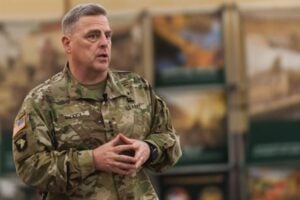
82nd Airborne soldiers train Iraqis to fire on the move
WASHINGTON: After a decade of debate, the US Army is finally creating permanent units dedicated to advising foreign forces. The six new Security Force Assistance Brigades will be a marked departure from the ad hoc training teams used throughout the wars in Afghanistan and Iraq. They would also be well suited to build up local allies to take down the Islamic State, which the Trump Administration has made its top priority.
The advisor brigade initiative predates Trump, however: Gen. Mark Milley floated the idea publicly in 2015, in his first months as Army Chief of Staff. But the Army’s had a lot to think about, from the war in Ukraine to wargames in Pacific. That Milley would still push this plan through, and that the service would allocate about 3,000 of its most experienced troops to the six advisor brigades, suggests the service really is serious about learning the lessons of 15 years of guerrilla warfare — even as the Army reorients towards conventional warfare against nation-states such as Russia.

Gen. Mark Milley
That said, the advisor units have a secondary mission for major wars, as Milley has made clear from the start. To make the org chart for Security Force Assistance Brigade, you basically take a regular infantry or tank brigade and strip away all the junior troops. What’s left of the 4,000-strong combat brigade is 500 of the most senior officers and sergeants, the people with the experience to train a foreign military and the rank to command respect.
In a protracted conventional war, however, you could hastily recruit a few thousand privates and wrap them around this experienced cadre, growing the advisor brigade into a combat brigade. That should be significantly quicker than building a whole brigade from scratch, since it’s those senior soldiers that are hardest to find and take the longest to train.
“The SFABs can serve a dual purpose,” said Lt. Gen. Joseph Anderson, the Army’s chief of operations, in a statement. “They are the day-to-day experts combatant commanders need to train, advise and assist our partners overseas, but they can serve also as a standing chain of command for rapidly expanding the Army.”
To train the advisor brigade troops, the Army is also creating a Military Advisor Training Academy at Fort Benning, Ga., prestigious home of the infantry and armored warfare schools. The new academy will complement the long-established but occasionally embattled Peacekeeping & Stability Operations Institute: While PKSOI is part of the Army War College in Carlisle, Pa., the highest level of professional military education, the advisor academy will be embedded in muddy-boots training at Benning. For a service that takes its “schoolhouses” seriously as cultural institutions, creating an academy for advisors shows a commitment to further institutionalizing the lessons of the long post-9/11 wars.
After Vietnam, the Army willfully forgot about guerrilla warfare in its eagerness to refocus on the Russians. Maybe this time will be different.
Army eyes TBI monitoring, wearable tech for soldiers in high-risk billets
“We are also looking at what additional personal protective equipment we can provide to our folks, especially instructors and others who are routinely exposed to blast pressure,” said Army Secretary Christine Wormuth.


























